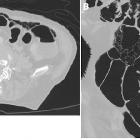pneumatosis cystoides intestinalis







Pneumatosis cystoides intestinalis is a radiopathological entity characterized by the presence of multiple gas-filled cysts in the submucosa and/or gastrointestinal subserosa of the small intestine. It is a subtype of pneumatosis with specific features, which can occur anywhere along the gastrointestinal tract, including the colon, rectum and mesentery. When associated with the colon it is known as pneumatosis cystoides coli.
Epidemiology
Pneumatosis cystoides intestinalis is an uncommon entity, reportedly occurring most commonly in the 6 decade, and has an incidence of ~0.03%.
Pathology
Pneumatosis cystoides intestinalis can be categorized as primary (idiopathic) or secondary. Once identified is it important to try and identify an underlying cause/association, if present.
When the cysts rupture it may cause “benign pneumoperitoneum” as there is an absence of peritoneal irritation.
Associations
There have been proposed associations with chronic pulmonary, connective tissue and gastrointestinal diseases, including:
- inflammatory bowel disease
- necrotizing enterocolitis
- sigmoid volvulus
- COPD
- progressive systemic sclerosis
- gastrointestinal hypermobility
Radiographic features
Depending on the degree of gastrointestinal involvement, pneumatosis cystoides intestinalis may be diffuse, segmental or localized.
It is typically characterized by well-circumscribed cysts/”bubbles” within the walls of the hollow gastrointestinal viscera. These cysts are surrounded by regular and non-inflamed mucosa. A small volume pneumoperitoneum may be present.
If diffuse, it may appear to occupy large areas of the abdomen with a honeycomb pattern that appears similar to that of interstitial lung disease.
See also
Siehe auch:
- Pneumatosis intestinalis
- intramurale Gaseinschlüsse
- pneumatosis intestinalis (mnemonic)
- Pneumatosis cystoides des Kolons
- emphysematöse Kolitis
- luftgefüllte Zysten am Darm
- Pneumatosis intestinalis bei COPD
- Freie abdominelle Luft bei COPD
und weiter:

 Assoziationen und Differentialdiagnosen zu Pneumatosis cystoides intestinalis (PCI):
Assoziationen und Differentialdiagnosen zu Pneumatosis cystoides intestinalis (PCI):

